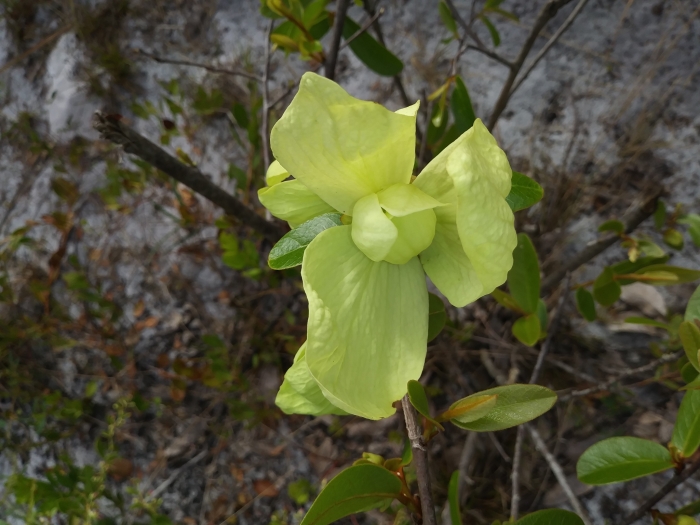Bigflower Pawpaw
(Asimina obovata)
Bigflower Pawpaw (Asimina obovata)
/
/

Daniel Estabrooks
Public Domain
Image By:
Daniel Estabrooks
Recorded By:
Copyright:
Public Domain
Copyright Notice:
Photo by: Daniel Estabrooks | License Type: Public Domain | License URL: http://creativecommons.org/publicdomain/zero/1.0/ | Rights Holder: Daniel Estabrooks | Publisher: iNaturalist | Date Created: 2020-03-30T09:39:48-07:00 |




















































Estimated Native Range
Summary
Asimina obovata, commonly known as Bigflower Pawpaw, is a deciduous tree or large shrub native to the understory of hardwood forests, floodplain forests, and riverbanks in Florida. It can grow up to 15 feet (4.5 meters) tall and wide, often with a clumping habit due to root suckers. The Bigflower Pawpaw is notable for its large, showy white flowers that bloom from late winter to early summer, which can be up to 6 inches (15 cm) across. These are followed by sizeable green, edible fruits that have a custard-like flavor. The plant’s pollen is unique in that it is shed as permanent tetrads. Asimina obovata is an important host plant for the larvae of the zebra swallowtail butterfly and the pawpaw sphinx moth, contributing to biodiversity.
The Bigflower Pawpaw is valued for its ornamental flowers, edible fruit, and its ability to attract wildlife. It is used in naturalistic plantings, as an understory tree in larger landscapes, and for its potential in native plant gardens. It prefers a partially shaded location but can tolerate full sun if adequately watered. The plant thrives in well-drained, fertile soils and requires low to medium amounts of water once established. While generally low-maintenance, it can spread through root suckers, which may need management in smaller gardens. There are no significant disease or pest issues, but fruit may require protection from wildlife.CC BY-SA 4.0
The Bigflower Pawpaw is valued for its ornamental flowers, edible fruit, and its ability to attract wildlife. It is used in naturalistic plantings, as an understory tree in larger landscapes, and for its potential in native plant gardens. It prefers a partially shaded location but can tolerate full sun if adequately watered. The plant thrives in well-drained, fertile soils and requires low to medium amounts of water once established. While generally low-maintenance, it can spread through root suckers, which may need management in smaller gardens. There are no significant disease or pest issues, but fruit may require protection from wildlife.CC BY-SA 4.0
Plant Description
- Plant Type: Tree, Shrub
- Height: 4-12 feet
- Width: 2-6 feet
- Growth Rate: Moderate
- Flower Color: White
- Flowering Season: Spring
- Leaf Retention: Deciduous
Growth Requirements
- Sun: Full Sun, Part Shade
- Water: Medium
- Drainage: Fast
Common Uses
Bird Garden, Butterfly Garden, Deer Resistant, Low Maintenance, Showy Flowers
Natural Habitat
Understory of hardwood forests, floodplain forests, and riverbanks in Florida
Other Names
Common Names: Flag Pawpaw
Scientific Names: , Asimina obovata, Annona grandiflora, Pityothamnus obovatus, Annona obovata, Anona obovata, Orchidocarpum grandiflorum, Porcelia grandiflora, Uvaria obovata,
GBIF Accepted Name: Asimina obovata (Willd.) Nash